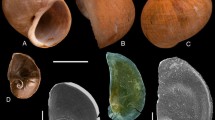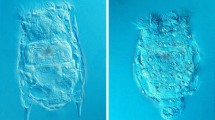Summary
Marr's (1962) hypothesis on the descent of eggs and ascent of early larvae of Euphausia superba is examined in the light of investigations prior to and including field investigations in January 1985. Two deep stations (4100 m) west of the South Orkney Islands yielded more than 6600 eggs and early larvae per 100 m3 in the 1000 to 2000 m layer; also below 2000 m eggs and naupliar stages occurred. Sinking speed and sinking depth of krill eggs are discussed in the light of laboratory experiments of Marschall (1983), Quetin and Ross (1984), and George and Strömberg (1985). Hatching depths calculated from the experimental data on sinking rate and incubation time tend to be shallower than the deep occurrence of krill eggs at sea. Possibly krill may spawn not only near the surface but also at depths of several hundred meters. The high abundance of naupliar stages in smaples from our deepest layer corrobrate the presumption of Marschall and Hirche (1984) that the nearly immobile nauplii still sink and that the larvae begin to rise only when they have reached the metanaupliar stage.
Similar content being viewed by others
References
Brinton E, Huntley M, Townsend AW (1986) Larvae of Euphausia superba in the Scotia Sea and Bransfield Strait in March 1984-development and abundance compared with 1981 larvae. Polar Biol 5:221–234
Fraser FC (1936) On the development and distribution of young stages of krill (Euphausia superba) Discovery Rep 14:3–190
George RY (1984) Ontogenetic adaptations in growth and respiration of Euphausia superba in relation to temperature and pressure. J Crust Biol 4 (Spec No 1):252–262
George RY, Strömberg J-O (1985) Development of eggs of Antarctic Krill Euphausia superba in relation to pressure. Polar Biol 4:125–133
Hempel G (1985) Die Expedition Antarktis III mit FS Polarstern 1984/85. Ber Polarforsch 25, 222 pp
Hempel I (1985) Vertical distribution of larvae of Antarctic krill Euphausia superba In: Siegfried WR, Condy PR, Laws RM (eds) Antarctic nutrient cycles and food webs. Springer, Berlin Heidelberg New York, pp 308–310
Hempel G, Heywood RB (1982) Joint biological expedition on RRS John Biscoe, February 1982. Ber Polarforsch 5, 39 pp
Hempel I, Hempel G, Baker A de C (1979) Early life history stages of krill (Euphausia superba) in Bransfield Strait and Weddell Sea. Meeresforschung 27:267–281
Ikeda T (1984) Development of the larvae of the Antarctic krill (Euphausia superba Dana) observed in the laboratory. J Exp Mar Biol Ecol 75:107–117
Mackintosh NA (1972) Life cycle of antarctic krill in relation to ice and water conditions Discovery Rep. 36:1–93
Marr JWS (1962) The natural history and geography of the Antarctic krill (Euphausia superba Dana). Discovery Rep 32:33–464
Marschall H-P (1983) Sinking speed, density and size of Euphausiid eggs. Meeresforschung 30:1–9
Marschall H-P, Hirche H-J (1984) Development of eggs and nauplii of Euphausia superba. Polar Biol 2:245–250
Marschall S, Mizdalski E (1985) Euphausiid larvae in plankton samples from the vicinity of the Antarctic Peninsula, February 1982. Ber Polarforsch 21, 47 pp
Piatkowski U (1983) Joint biological expedition on RRS John Biscoe, February 1982 (II). Data of micronecton and zooplankton hauls. Ber Polarforsch 11, 40 pp
Piatkowski U, Klages N (1983) German Antarctic Expedition 1980/81 with FRV Walther Herwig and RV Meteor. 1st Int BIOMASS Exp (FIBEX). Data of micronecton and zooplankton hauls. Ber Polarforsch 15, 58 pp
Quetin LB, Ross RM (1984) Depth distribution of developing Euphausia superba embryos, predicted from sinking rates. Mar Biol 79:47–53
Rakusa-Suszczewski S (1984) Krill larvae in the Atlantic sector of the Southern Ocean during FIBEX 1981. Polar Biol 3:141–147
Ross RM, Quetin LB (1982) Euphausia superba: fecundity and the physiological ecology of its eggs and larvae. Antarct J US 17:166–167
Ross RM, Quetin LB (1985) The effect of pressure on the sinking rates of the embryos of the Antarctic krill, Euphausia superba. Deep-Sea Res 32:799–807
Rustad R (1930) Euphausiacea, with notes on their biogeography and development. Nor Vidensk-Acad Oslo Arbok 5:1–83
Schnack SB (1985) A note on the sedimentation of particulate matter in Antarctic waters during summer. Meeresforschung 30:306–315
Voronina NM (1974) An attempt at a functional analysis of the distributional range of Euphausia superba. Mar Biol 24:347–352
Witek Z, Koronkiewicz A, Soszka GJ (1980) Certain aspects of the early life history of krill Euphausia superba Dana (Crustacea). Pol Polar Res 1:97–115
Author information
Authors and Affiliations
Rights and permissions
About this article
Cite this article
Hempel, I., Hempel, G. Field observations on the developmental ascent of larval Euphausia superba (Crustacea). Polar Biol 6, 121–126 (1986). https://doi.org/10.1007/BF00258263
Received:
Accepted:
Issue Date:
DOI: https://doi.org/10.1007/BF00258263




